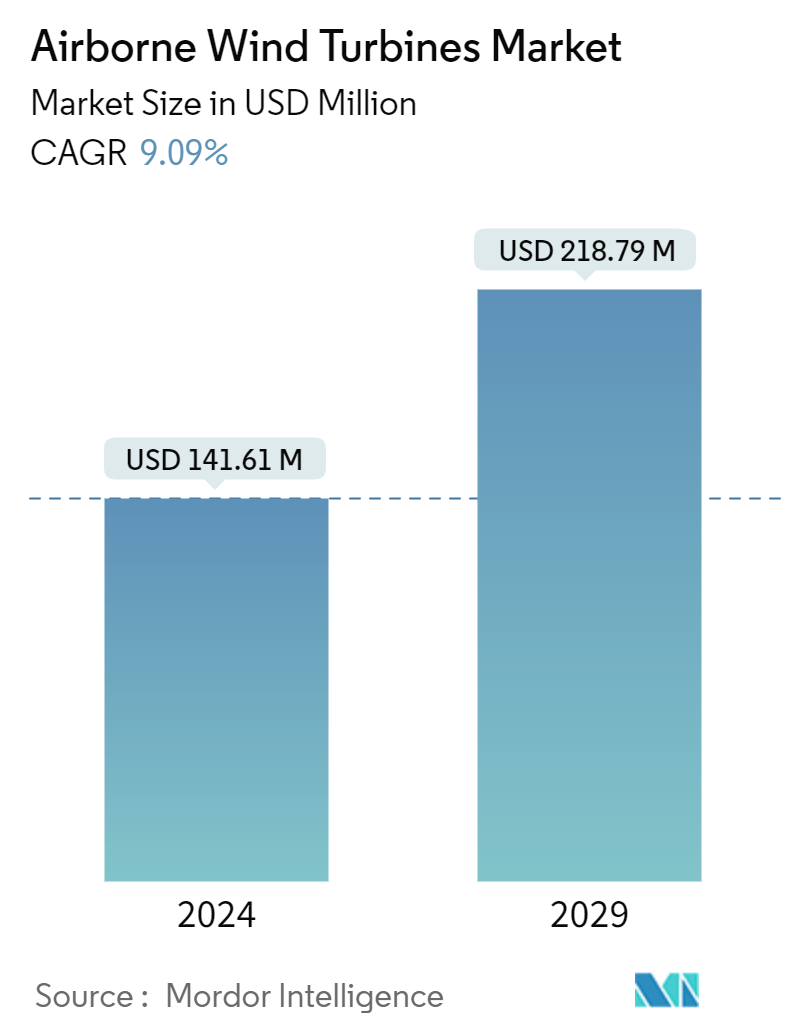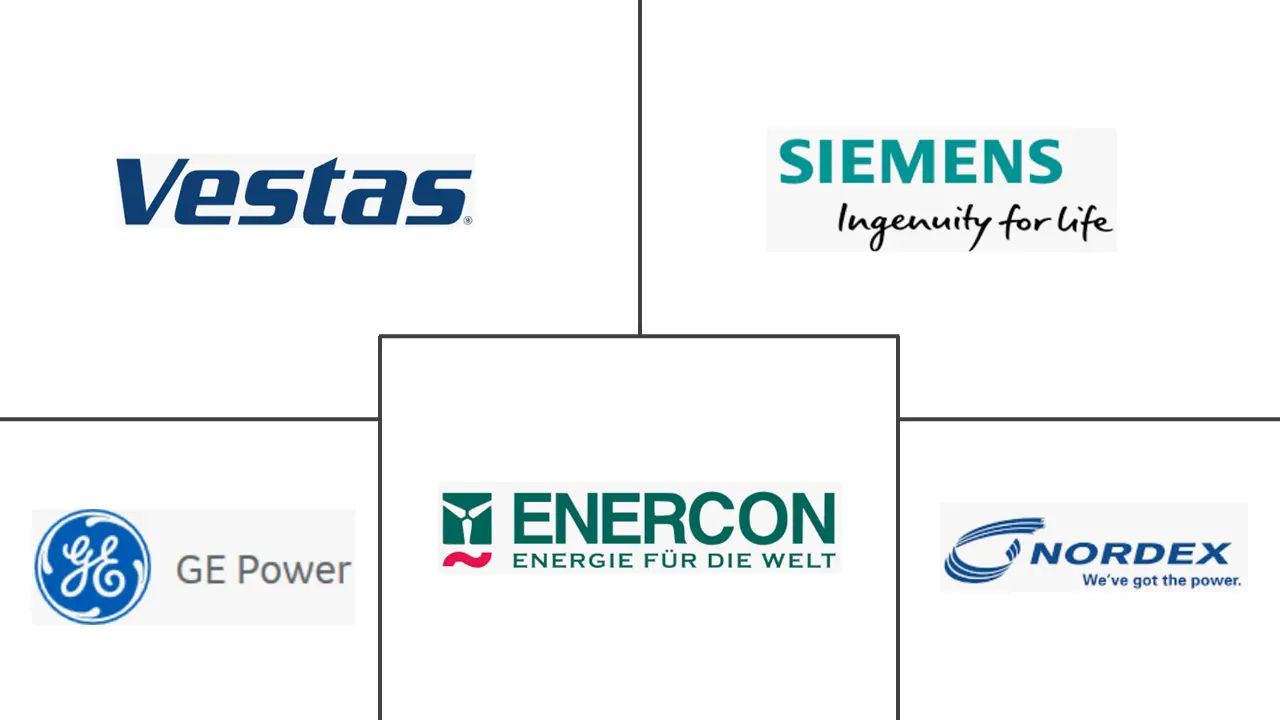Market Size of Airborne Wind Turbines Industry

| Study Period | 2019 - 2029 |
| Market Size (2024) | USD 141.61 Million |
| Market Size (2029) | USD 218.79 Million |
| CAGR (2024 - 2029) | 9.09 % |
| Fastest Growing Market | Asia Pacific |
| Largest Market | Europe |
Major Players
*Disclaimer: Major Players sorted in no particular order |
Airborne Wind Turbines Market Analysis
The Airborne Wind Turbines Market size is estimated at USD 141.61 million in 2024, and is expected to reach USD 218.79 million by 2029, growing at a CAGR of 9.09% during the forecast period (2024-2029).
Factors such as low maintenance costs for wind energy technologies and the rise of companies using airborne wind energy systems across the world are expected to drive the market between 2024 and 2029.
On the other hand, the high cost of building and installing turbines and the lack of proper developers are expected to hinder the market's growth.
Nevertheless, technological advancements like airborne wind energy (AWE) technologies, which are fundamentally new and require significant further development, are expected to create several future market opportunities from 2024 to 2029.
Europe is expected to be the largest and fastest-growing region in the global airborne wind energy market between 2024 and 2029.
Airborne Wind Turbines Industry Segmentation
Airborne wind energy converts wind energy into electricity using tethered flying devices. Several electricity companies provide their consumers with power from wind farms. The idea behind an airborne wind turbine is a wind turbine with rotor support. These turbines are built at higher altitudes, which results in higher velocity and persistence in wind energy, thereby saving the cost of constructing a tower.
The airborne wind turbine market is segmented by technology, application, and geography. By technology, the market is segmented into larger turbines (above 3 MW) and smaller turbines (Less than 3 MW). By application, the market is segmented into offshore and onshore. The report also covers the market size and forecasts for the airborne wind energy market across major regions, such as Asia-Pacific, North America, Europe, South America, and Middle East and Africa.
For each segment, the market sizing and forecasts are made based on revenue (USD).
| Technology | |
| Larger Turbines (above 3 MW) | |
| Smaller Turbines (Less than 3 MW) |
| Application | |
| Offshore | |
| Onshore |
| Geography [Market Size and Demand Forecast till 2028 (for regions only)] | ||||||||||||
| ||||||||||||
| ||||||||||||
| ||||||||||||
| ||||||||||||
|
Airborne Wind Turbines Market Size Summary
The airborne wind energy market is poised for significant growth, driven by the increasing adoption of airborne wind energy systems globally. These systems offer low maintenance costs and the potential for high-altitude wind energy capture, making them an attractive alternative to traditional wind energy technologies. Despite challenges such as high installation costs and a shortage of developers, technological advancements in airborne wind energy (AWE) are expected to create numerous opportunities in the coming years. Europe is anticipated to lead the market, benefiting from its substantial onshore wind capacity and ambitious renewable energy targets. The region's focus on reducing reliance on fossil fuels and enhancing energy efficiency is expected to drive the adoption of AWE systems, which offer a lower levelized cost of energy compared to established wind technologies.
The market landscape is semi-consolidated, with key players like GE Power, Enercon GmbH, Nordex SE, Vestas Wind Systems AS, and Siemens AG actively investing in AWE technologies to expand their market share. These companies are leveraging joint ventures, mergers, and acquisitions to enhance their service offerings and maintain competitiveness. The scalability and flexibility of AWE systems make them suitable for various applications, from powering remote communities to supporting large-scale grid integration. As countries strive to diversify their energy sources and achieve sustainability goals, the demand for airborne wind energy systems is expected to rise, positioning the market for robust growth in the foreseeable future.
Airborne Wind Turbines Market Size - Table of Contents
-
1. MARKET OVERVIEW
-
1.1 Introduction
-
1.2 Market Size and Demand Forecast in USD billion, till 2029
-
1.3 Recent Trends and Developments
-
1.4 Government Policies and Regulations
-
1.5 Market Dynamics
-
1.5.1 Drivers
-
1.5.1.1 Companies Focused to Enhance Airborne Wind Energy
-
1.5.1.2 Low Maintenance Costs of Wind Energy Technologies
-
-
1.5.2 Restraints
-
1.5.2.1 Cost of Building and Installing Turbines
-
-
-
1.6 Supply Chain Analysis
-
1.7 PESTLE Analysis
-
1.8 Industry Attractiveness - Porter's Five Forces Analysis
-
1.8.1 Bargaining Power of Suppliers
-
1.8.2 Bargaining Power of Consumers
-
1.8.3 Threat of New Entrants
-
1.8.4 Threat of Substitutes Products and Services
-
1.8.5 Intensity of Competitive Rivalry
-
-
-
2. MARKET SEGMENTATION
-
2.1 Technology
-
2.1.1 Larger Turbines (above 3 MW)
-
2.1.2 Smaller Turbines (Less than 3 MW)
-
-
2.2 Application
-
2.2.1 Offshore
-
2.2.2 Onshore
-
-
2.3 Geography [Market Size and Demand Forecast till 2028 (for regions only)]
-
2.3.1 North America
-
2.3.1.1 United States
-
2.3.1.2 Canada
-
2.3.1.3 Rest of North America
-
-
2.3.2 Europe
-
2.3.2.1 Germany
-
2.3.2.2 France
-
2.3.2.3 United Kingdom
-
2.3.2.4 Italy
-
2.3.2.5 Spain
-
2.3.2.6 Turkey
-
2.3.2.7 Nordic
-
2.3.2.8 Rest of Europe
-
-
2.3.3 Asia-Pacific
-
2.3.3.1 China
-
2.3.3.2 India
-
2.3.3.3 Japan
-
2.3.3.4 South Korea
-
2.3.3.5 Australia
-
2.3.3.6 Thailand
-
2.3.3.7 Malaysia
-
2.3.3.8 Indonesia
-
2.3.3.9 Vietnam
-
2.3.3.10 Rest of Asia-Pacific
-
-
2.3.4 South America
-
2.3.4.1 Brazil
-
2.3.4.2 Argentina
-
2.3.4.3 Chile
-
2.3.4.4 Colombia
-
2.3.4.5 Rest of South America
-
-
2.3.5 Middle East and Africa
-
2.3.5.1 Saudi Arabia
-
2.3.5.2 United Arab Emirates
-
2.3.5.3 South Africa
-
2.3.5.4 Qatar
-
2.3.5.5 Nigeira
-
2.3.5.6 Egypt
-
2.3.5.7 Rest of Middle East and Africa
-
-
-
Airborne Wind Turbines Market Size FAQs
How big is the Airborne Wind Turbines Market?
The Airborne Wind Turbines Market size is expected to reach USD 141.61 million in 2024 and grow at a CAGR of 9.09% to reach USD 218.79 million by 2029.
What is the current Airborne Wind Turbines Market size?
In 2024, the Airborne Wind Turbines Market size is expected to reach USD 141.61 million.

